Category: Nature Journaling, Wonder Wednesday
Have you been seeing lots of really cool close up pictures lately and wondering how do they get that magic on their camera phone? Well it may look like magic, but it’s just a macro shot!
I am a giant fan of macro photography. I have been since I was a photo major in art school and used to take macro shots with my film camera
Or really since I used to read Ranger Rick magazine as a kid and loved the close up pictures that you had to guess what the object was! remember those?
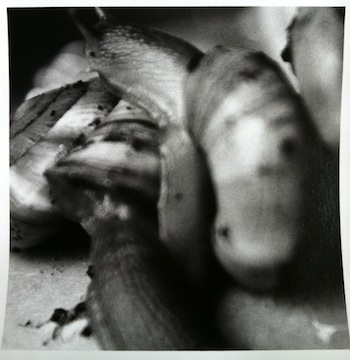
I took this macro shot of snails with a traditional macro lens on an SLR camera in 1996 when I did a summer semester abroad in France and Italy. I found a bunch in the garden after a rain shower, so of course I had to play with them!
Macrophotography is the technique of creating photographs of small items in larger than life size. Even the boring definition sounds magical just like a good macro shot can make the mundane magical!!
Macro is great for:
- Distorting objects so the image produced focuses more on the shapes and colors than the actual thing (for having fun with art like in the snail pic above)
- Magnifying tiny objects for better observation (like for nature study in the bug pic below)
- Zooming in on a part of an object to the point the original object is unrecognizable and its details take center stage (like in Ranger Rick kinda like in the lichen shot below but more out of context)
Macro photo is awesome for taking really interesting pictures of bugs, flower buds, pollen, water droplets, snowflakes and other teeny things, patterns, textures, and for producing extreme close ups with shallow depth of field (focal object is sharp and background is blurred.)
It’s also fantastic for sparking wonder and inspiring art, learning, and connections from the fascination of seeing so close up. (A reason why the back page of Ranger Rick was so popular!)
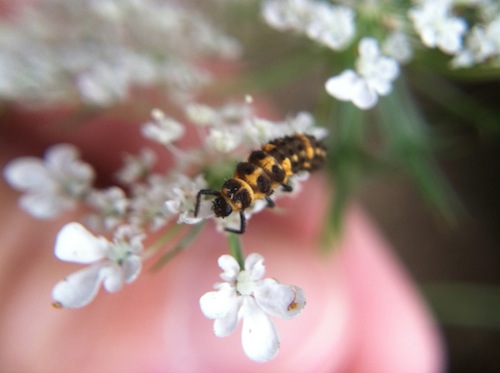
Getting up close and personal with a juvenile ladybug on fennel flowers. Taken last summer with my point and shoot on macro function.
But isn’t it expensive?
Macrophotography used to be (and can still be) quite expensive because the lens required is no joke, but with the advent of digital pretty much anyone with a phone or point and shoot can join in on the fun!
Most point and shoot digital cameras come with a really great macro function built in. It’s often symbolized by a little tulip looking flower.
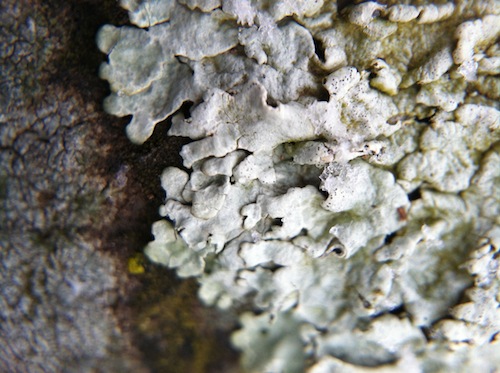
Bring lichen to life!! Taken last week with my phone macro.
For phone cameras, try an add on macro lens like the Easy Macro. It’s only about $13 and is a little lens embedded in a rubber band that fits around your phone. Easy is right!
Whether you have a $7000 DSLR set up or a rubber band lens on your phone, just because you take a macro shot doesn’t mean it will look good. So check out a few tips to set you up for macro success.
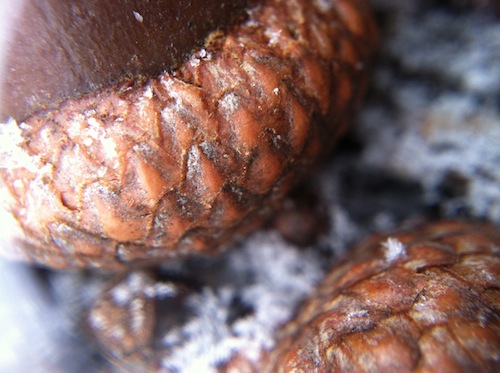
Amazing texture on these acorn tops in the snow! Taken last week with my phone macro.
3 Easy Tips for Great Macro Shots:
1. Have good bright light. Macro shots require more light because you are in so close. If you can’t get it to focus, you probably need more light. Try moving your body to a different position so the light isn’t blocked or add a supplementary light source.
(Bright light is different than hot light though. “Hot” light is like really intense sunlight that can blare out a subject to all white.)
Often with point and shoot cameras a supplementary light will come on with the macro function. This is quite helpful. Avoid flashes if possible because the light is “hot” and will likely distort your colors, although a flash sometimes looks good as a fill in hot sunlight or for getting abstract. Never say never in art!
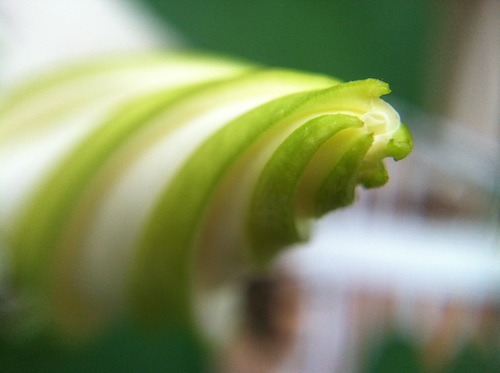
Bright light = high impact and sharp focus. Taken last summer with my phone macro.
2. Keep the camera steady at all costs. This may mean even holding your breath while you take the shot as well as bracing your arms and even legs like a tripod against something steady. Zooming in on the object in such a magnified way magnifies all your little movements.
Do whatever you must to keep steady. Lay down, lean against something, stick out your rear and look silly, and really, do hold your breath when you push the “shutter” button. The perfect shot is worth it!
Back in the old days I’d use a shutter release cable so you wouldn’t even touch the camera and risk your heartbeat blurring the shot!
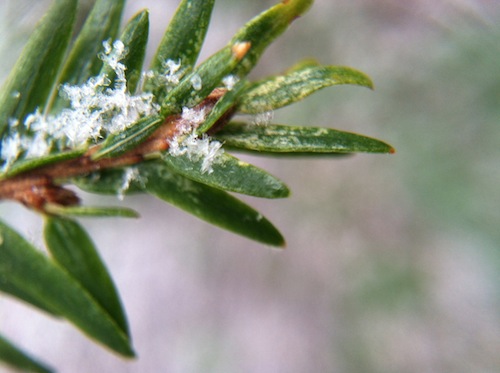
I though I had it steady, but see it’s slightly out of focus. Should have held my breath better! Taken last week with my phone macro.
3. When focusing, go in very close and ease your way out until the object comes into focus. Gently, slowly, and carefully move the camera closer and further away from the subject in a short close up range.
Watch for changing focal planes because as you ease away, different aspects of your subject may come into focus and surprise you. And always take more than one shot because you never know what shot will be the best out of the bunch until you look at them all!
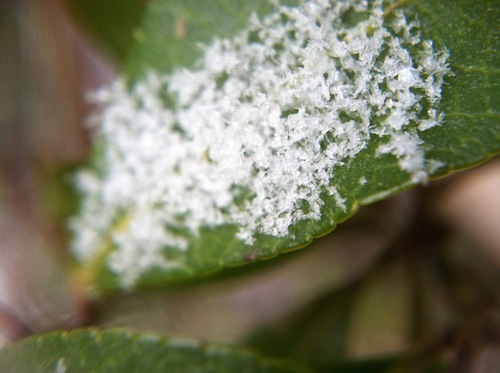
See the focal plane of these snowflakes and the leaf? It’s like a little line of sharp focus that blurs outward. Taken last week with my phone macro.
+ Remember to consider the composition of the entire frame and not only what your subject looks like. Yes, macro is about the killer close up, but if the entire shot isn’t framed consciously, it will take away from your subject.
Macro photography is just really good fun, so why not give it a try? Watch your child’s wonder burst into flames at the surprises seen through a macro eye! Get a lens for your adolescent and entice them to go on a nearby nature photo exploration with you!
Just get out there and discover all the teeny tiny wonders that await!

You can bring the smallest details of a tiny basil flower into focus with a little care.
What would you like to see up close?
Feathers? Flowers? Ice? A butterfly face? Share in the comments below!
Share your macro pics on Instagram #wingswormsandwonder
Seeds to Sprout:
Spring Sale and Giveaway March 18-20!! Celebrate the beginning of spring! All online nature journaling classes are 15% off, & with each purchase you are entered to win 1 of 2 quarterly spots in The Journey Within Art Journaling course (in which I also teach every quarter!) Be sure you have joined my email list! All the details on how to cash in and win come out tomorrow!!
Like my lichen shot? Learn more about lichen in this post Real Lichen Aren’t Werewolves
Want to learn to draw the nature from your macro shots? Check out the Wings, Worms, and Wonder online nature journaling school!
Some of my favorite macro photographers on Instagram (beside myself of course :)) are:
@mudtometeors_dawnsuzette – She takes the best snowflake shots and is from who I learned about the Easy Macro phone lens.
@nature_nrd – Remember her #tinyadventurefriday shots I showed in a post a few weeks ago? She really knows how to have fun with macro!
@rbayon – He takes macro insect shots to the next level!

This snail I found in my backyard garden eating a cherry tomato last summer and took the shot with my phone macro lens. I guess I just can’t get past how cool snails look in macro!
Comments are closed.
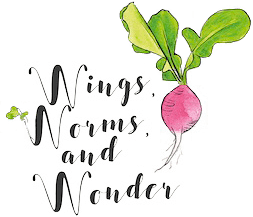
Wow, Kelly! Thanks so much for the shout-out! Am honored you like my photos! Much appreciated!
Of course Ricardo!! Your photos are awesome!
What an amazing post and the helpful hints from your expertise as an artist are wonderful, Kelly!
Thank you so much Carolyn!! I am so glad you find them useful!